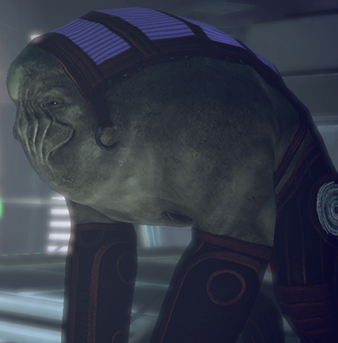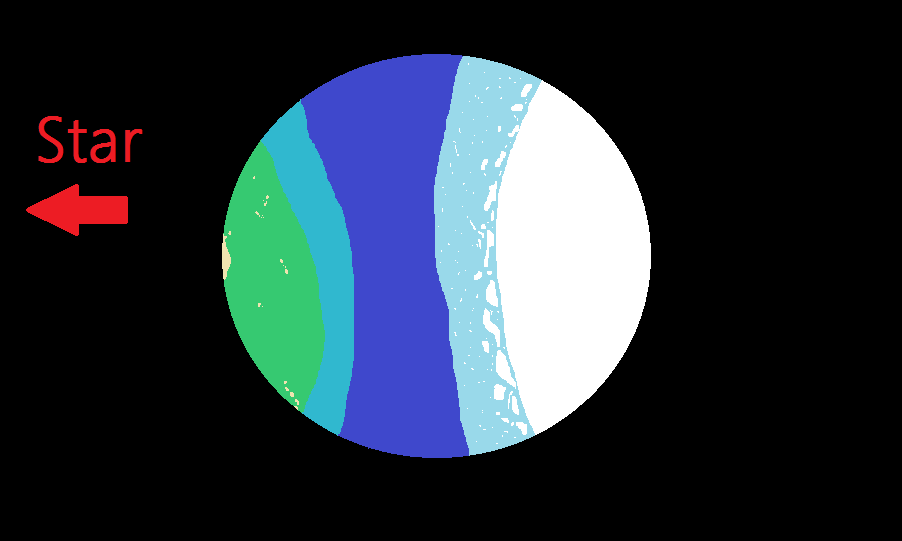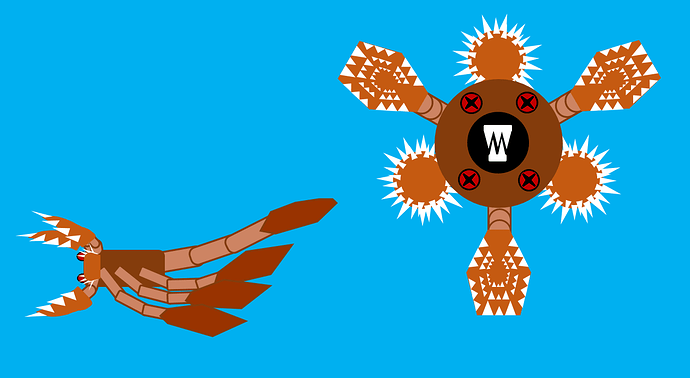So it lives on a tidally locked ocean world which orbiting a red dwarf star? Well, the planet would likely look a little something like this:
On the side of the planet furthest from the star there would likely be a large ice sheet (assuming we’re dealing with water oceans and not something else entirely). Given that this planet also orbits a relatively dim star, this ice sheet would likely cover at least a third, if not half of the planet. Ice floes would likely extend out from this for quite a ways, meaning that any creature living on the side of the planet furthest from the star would have to have some sort of blubber or maybe fur (although I’m not sure how well fur works for insulation underwater…).
On the other side of the planet, it would be a very different story. I have made this side slightly greenish to represent a large algae cloud which would cover this side of the world. Occasional sandy/rocky islands would occasionally peak out from this cloud, however, they would likely be sparsely populated, if at all. A small continent might also appear at the point closest to the star, but on the same hand, it might not. The water on this side of the world would also be slightly shallower, and considerably warmer. A creature living on this side of the world would not need nearly as much insulation, and, in fact, insulation may even be detrimental on this side.
In the middle, between these two extremes, would be a fairly deep ring of ocean, with a temperature somewhere between the two other “biomes.” Here you might find creatures which are something of a mix between those who live on the more extreme parts of the world.
Now that I’m done explaining the difficulties of the planet, I think it is time to move onto the creature itself.
First off, this creature would also need some way to survive the high gravity of its world. With this, there are two routes we could go. If it is a vertebrate, it would likes have very squat, strong bones, and considerable muscle mass. The other, and in my opinion more likely option, would be something along the lines of a crab, possessing a hard outer shell which protects its insides from getting crushed by the high pressure of its home world. Of course, being a predatory animal, this thing would need some way to get around. Flippers are probably the most likely candidate, but I have a more interesting idea. What is it possessed a sort of biological “jet,” similar to those used by Octopi and squid? Although both options are possible, a “jet” propulsion system would make for a creature which can travel very quickly, but only really in one direction. Because of this major drawback, it would likely also possess one pair of flippers which it would use for turning and re-positioning itself. An interesting idea for a creature native to the colder half of the planet would be to have it be a burrowing creature, which digs into the many icebergs which dot that side of the world, and shoots itself out, impaling/grabbing any unsuspecting prey which pass too close to its hiding hole. Another thing I just want to address really quickly here is the fact that on a world like this, eyes are almost entirely useless. Half of the planet is in constant darkness because no light from the star can reach it, and the other half would be covered in a massive algae cloud, which would also block any light. On top of this, water also does a fairly good job of blocking light. So I say this not to disappoint you, but merely to point out that other senses would take precedent over sight, such as the ability to detect vibrations, electrical signals, heat, smells, etc. Sorry. So, anyway, the base creature would be a sort of flipper crab, possible with a lobster-like tail for slower, less stressing locomotion, which can shoot itself about at very high speeds using what essentially amounts to a high-pressure water gun. It can not see, but might have other senses which we do not in its place.
Now, I’m not done yet. This flipper crab would also likely come in several species, at least one being native to each region of the planet. The species living in the cold region would need some sort of insulation, likely in the form of blubber. They would probably be a bit bulkier than their brethren, perhaps necessitating the sort of ambush predation I suggested earlier. A creature living on the warm, algae-covered half of the world would likely have a weak sense of sight, and possibly possess more fan-like flippers than its northern brethren. These fan-like flippers would help both with locomotion as well as with keeping the animal cool in the much hotter waters. It would likely have less use for its jets than its arctic cousins, seeing as it is far less bulky, and therefore already faster creature. Another interesting idea for this warm-water living creature could be that it actually feeds upon the algae which is all too present in its natural environment, although, seeing as you said it was carnivorous, it would probably just feed on the creatures which feed on the algae. Finally, a creature living in the middle band would be something of a mix of the two. It may possess some blubber, its flippers would probably be slightly fan-like, though not nearly to the extent of its warm-loving counterpart. An interesting idea for this animal could actually be to have it so that the creature living on the cold side of the world can’t mate with the creatures living on the warm side, but both can mate with those living in the middle.
I hope this wasn’t too long, but I honestly love thought experiments like this, and really hope you take my input into consideration when designing this creature




